Grassland Productivity and Ecosystem Services
- Publisher
CABI - Published
13th December 2011 - ISBN 9781845938093
- Language English
- Pages 296 pp.
- Size 6.875" x 9.75"
- Images 34 illus
Grassland ecosystems are deeply affected by human activities and need appropriate management to optimize trade-offs between ecosystem functions and services. Until now they have mainly been analyzed as agro-ecosystems for animal production but this book looks beyond the role of grassland as a feeding ground, and evaluates other important processes such as carbon sequestration in soils, greenhouse gas regulation and biodiversity protection. This authoritative volume expertly highlights the need for an immediate balance between agriculture and ecological management for sustainability in the future.
Introduction: Food security and environmental impacts; challenge for grassland sciences
1) Primary production of grasslands, herbage accumulation and use, and impacts of climate change.
Section 1: Productivity and use of grassland resource
2) Nutritional constraints for grazing animals and the importance of selective grazing behavior.
3) The influence of vegetation characteristics on foraging strategies and ingestive behavior.
4) Diversity, productivity and stability in grazing systems.
5) Importance of scale in the management of grassland resources.
6) Livestock production styles and managing grassland ecosystems.
Section 2: Grasslands as regulating biogeochemical cycles and environmental fluxes to hydrosphere and atmosphere
7) Carbon storage and organic matter dynamics in grassland soil.
8) Managing C and N in grassland systems. The adaptive cycle theory perspective.
9) Managing mineral N leaching in grassland systems.
10) Greenhouse gas emission from grassland area and mitigation.
11) Role and impacts of legumes in grasslands for high productivity and N gain from symbiotic N2 fixation.
12) Efficiency of Phosphorus Cycling in Different Grassland Systems.
Section 3: Grasslands as regulating biodiversity dynamics
13) Predicting biodiversity dynamics of grasslands under global changes) the role of long-term manipulation of climates.
14) Interactions between grassland management and species diversity.
15) Assessing the functional role of plant diversity in grasslands) a trait-based approach.
16) Exploiting genotypic and phenotypic plant diversity in grasslands.
17) Microbial diversity of grasslands, its functional role.
18) Soil fauna diversity and ecosystem functions in grasslands.
Section 4: Grasslands as component of sustainable farming
19) Role of grasslands in intensive animal production in North-West Europe. Conditions for a more sustainable farming system.
20) Management of grazing systems in New Zealand and environmental impacts.
21) Rangeland management for sustainable conservation of natural resources.
22) Opportunities and challenges for integrating North-American crop and livestock systems.
23) Integration of grasslands within arable crop systems in South-America.
Section 5: Grasslands as components of landscape ecology and agricultural systems at regional level
24) Temperate grasslands in catchment systems) the role of scale, connectivity and thresholds in the provision and regulation of water quality and quantity.
25) Integration of grasslands with forests at regional level.
26) Role of grasslands area within arable cropping systems for conservation or enhancing biodiversity at regional level.
27) Interactions between cereal cropping systems and pastoral areas as the base for a sustainable agriculture development in Mediterranean countries.
28) A way for developing integrated system at landscape level in tropical areas.
Gilles Lemaire
Gilles Lemaire is at INRA, France.
John Hodgson
John Hodgson is Professor Emeritus of Pastoral Science, Massey University, New Zealand.
Abad Chabbi
Abad Chabbi is at INRA, France.


